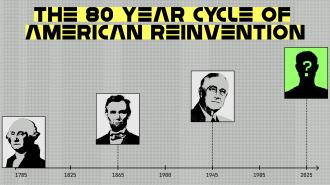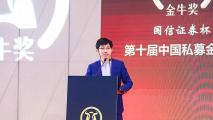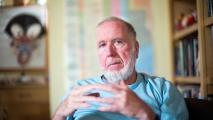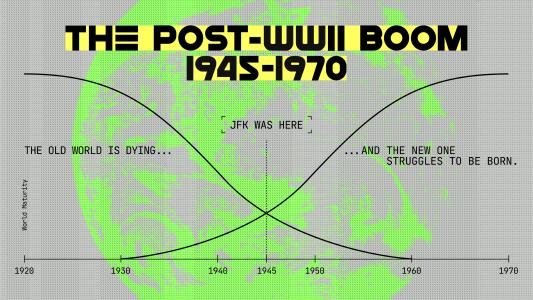A couple of weeks ago, I published an essay that went viral and is best summed up by its full title: “America is going through its every-80-year reinvention: Americans have gone through three historic junctures like what we’re witnessing today — and they happen on an uncanny 80-year cycle.”
The piece detailed the striking parallels between each of the previous reinventions, which are reflected in the above graphic using the images of recognizable presidents:
- 1785: The explosion of great progress that came off what the founders did around the Constitutional Convention
- 1865: The similar explosion of progress following the resolution of the Civil War
- 1945: The era of great progress that began after the end of World War II and lasted through the post-war boom
The essay went over this past history to give us new insights into the fourth reinvention of America, which is happening right now in what I call The Great Progression: 2025 to 2050. (Just to be clear, the famous face that will mark our era has yet to be determined, but it will not be Donald Trump — read last week’s essay to understand why.)
Why every 80 years? That is the question that readers kept pondering in the comments of that story. I honestly tried to figure out a way to weave the reasons into that piece, but explaining 250 years of American history was enough for one 3,000-word essay designed to be read on your phone.
The truth is that I will need this entire essay to explain what I think is behind this uncanny 80-year cycle. And, to give credit where credit is due, I will draw off the work of the pioneers in three separate fields who have influenced my thinking, several of whom I have met and interviewed in person, too.
The 80-year reinvention pattern in America is real, and we are heading into yet another one now.
One insight into the pattern has to do with the periodic alignment of four archetypal generations of Americans who are particularly well suited to drive transformational change. Bill Strauss and Neil Howe pioneered this field with their groundbreaking book “Generations,” which came out in 1992. It has since been followed by many other books, with Howe’s “The Fourth Turning is Here” being the most recent.
Another insight has to do with understanding how the really big technological revolutions play out over time and end up leading to golden ages characterized by peace, prosperity, and stability. One of the more recent big thinkers in this space is economist Carlota Perez, whose theories are best summed up in her book “Technological Revolutions and Financial Capital.”
And the third insight into the pattern has to do with economic long booms, which often are built on new technologies that scale up over time, but that also have their own dynamics of creative destruction. One of the pioneers of this field was Russian economist Nikolai Kondratiev, who explained the long waves of economic growth that are not affected by the crazy ups-and-downs of the stock market and the like.
Kondratiev and others in that field influenced my first book, “The Long Boom,” which was published in 1999. It predicted that the digital revolution would combine with globalization to drive unprecedented global growth — and it largely did.
I will not be going deep into the weeds on any of these theories, but I will sum them up to help you see what I see: the 80-year reinvention pattern in America is real, and we are heading into yet another one now.
The key constellation of American generations that aligns every 80 years
The precision of the 80-year cycle is what is most striking, and I think the generational theory is the one that best explains that phenomenon, so let’s look at it first.
A generation is generally defined as the humans who are born within a contiguous span of 20 years. Those who are born, raised, and come of age within the same period of time experience the world in similar ways and so develop similar characteristics.
If you grow up during a time of war, that will impact you and your childhood peers in certain ways, just like growing up in a peaceful boom time will impact another generation of children in different ways. In other words, each generation develops a kind of personality based on the world around it similar to how an individual child does.
Four active generations coexist at any one historical period given the limits of the human lifespan (so far). You can think of the developmental stages of those generations as children (ages 1 to 19), young adults (20 to 39), mid-life adults (40 to 59), and elder adults (60 to 80).
The personality of each generation is formed not just by what is happening in the world during its childhood, but also by the personality of the generation that parented it.
One big insight that Strauss and Howe had after studying the personalities of all generations in American history back through colonial times is that a consistent pattern emerges due to the interplay between the generations.
For example, some generations are strict parents and so raise a certain kind of highly protected child. When the members of that young generation grow up and have children, they often react to their own parenting by being more lenient. Their children might then be more independent and take more risks.
If you want to fully understand all the nuances of how this happens — and how it has happened again and again over American history — read the books I linked to above.
For the purposes of this essay, all you need to know is that there are four archetypal generations, and every 80 years, they happen to align in a certain constellation that coincides with America’s bursts of innovation and great progress. You can see these archetypes in the graphic below:
- The “Prophet” generation grew up in booming prosperity but then rebelled. It is highly individualistic and idealistic, and tends to produce leaders who are visionary. That’s the Boomers of today.
- The “Nomad” generation grew up neglected and so became highly independent. Its members are tough and entrepreneurial, and by their mid-life, they are the kind of practical leaders and managers who can get shit done. That’s our Gen Xers.
- The “Hero” generation grew up coddled and overprotected. Members of this generation are team players who are highly egalitarian, and when pushed in a crisis, they have what it takes to be heroic and sacrifice for the common good. That’s today’s millennials, who may have been unfairly maligned in the past, but arguably have their best days still ahead of them.
- The “Artist” generation grew up in the shadow of the Hero generation, with whom its values easily align. This gives the two generations a lot of social and political heft in the decades ahead. They rarely are the leaders, but the generation does produce a lot of artistic types — hence the name. Today they are Gen Z.
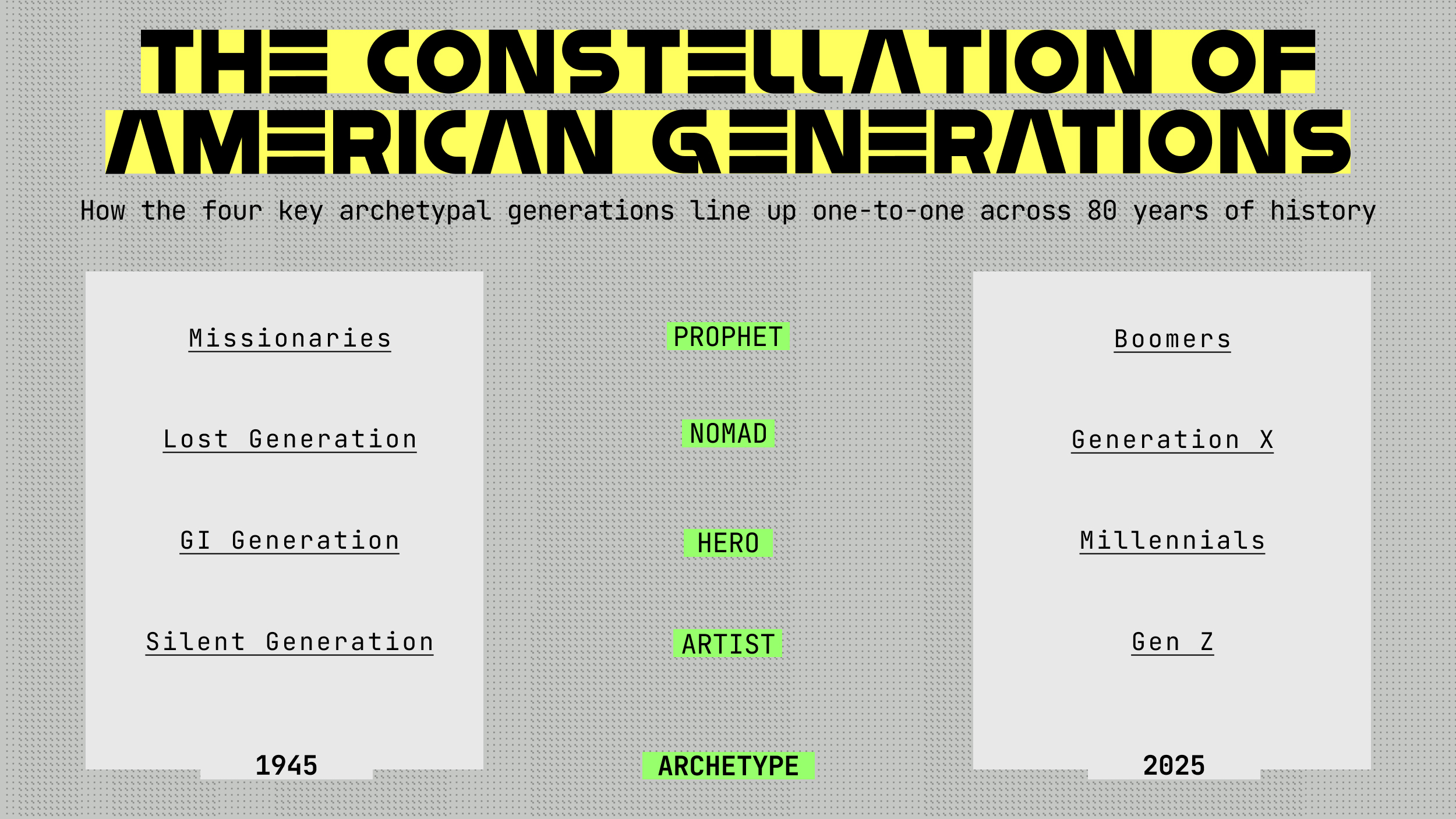
The point of this graphic is to show that the exact same constellation of generations that we have now came together in 1945 to solve the Great Depression, win World War II, and build the post-war world in the following 25 years.
Some of the iconic members of those past generations were:
- The Prophet: Franklin Delano Roosevelt, the president who envisioned the New Deal, was emblematic of The Missionary Generation.
- The Nomad: General George Patton, who led the tanks to take out Hitler, was from what was known at that time as The Lost Generation.
- The Hero: John F. Kennedy, a war hero who then became president during the great post-war boom, was from The G.I. Generation, a label still commonly referenced today.
- The Artist: Alan Alda, the ironic actor who played someone in the military in “M.A.S.H.” was from The Silent Generation.
The alignment of those archetypal generations shifts over time so that at some points you’ll have the Artist generation trying to lead the country as 60- to 80-year-old elder adults — and when that happens, transformational change rarely gets done. That might be one of the reasons that Silent Generation leaders like President Joe Biden and Nancy Pelosi could not pull it off.
However, that historic constellation of generations is now perfectly aligned in America. If you buy any part of this generational theory, it might give you more hope that transformational change is within reach.
As early as their 1992 debut, Strauss and Howe were predicting that this generational alignment would cause America to enter something they called “the fourth turning” right around this time. The three previous “turnings” roughly coincide with what I described in my recent essay as America’s last three reinventions.
Yet I would argue that the alignment of generations alone is not enough to bring about a full reinvention. You need the next two drivers of transformational change to line up, too.
A wave of revolutionary technologies is ready to transform America
I’m a tech guy, and over my career, I have increasingly come to understand the world through the lens of new technologies. I’ve come to believe that, to understand any era of human history, you have to start with an understanding of the technologies that humans of that time could utilize to drive the economy and reshape the society. The technology of any era defines what’s possible — and what’s impossible.
Once you see that an era’s technology is foundational to what’s possible, having insights into the new technologies that will expand the realm of possibility becomes very important. The more you understand about the potential of that new technology to reshape the economy and society, the better you will understand what the future will soon bring.
Technologies that can fundamentally reshape the economy and society take time to be introduced, adopted, and scaled. Many people over time have studied what is commonly understood in Silicon Valley as the “technology adoption curve,” which you can see in the graphic below.

Economist Carlota Perez, who I mentioned before, has studied many of Western history’s truly transformative technologies and sharpened our understanding of the larger impact across all of society as these technologies scaled up.
She saw how each of these transformative technologies began with what she called an “installation phase” that was marked by a gilded age during which the entrepreneurs who did the early innovating made spectacular fortunes. She also observed that financial capital goes into a frenzy of speculation during that early period that pretty much always ends in a crash. However, that crash is not the end of the technological buildout, but more like the true beginning.
We then enter what Perez calls the “deployment phase” of the technology, which brings about a golden age. During this period, the technology gets widely adopted through the entire economy and society, and many people benefit. If it’s a true general-purpose technology, productivity rates rise, the overall economy grows, and wealth spreads.
However, Perez emphasizes that strong government intervention is often necessary to guide the transition from speculative frenzy to sustained growth and ensure that the benefits of the new technology are widely distributed.
She identifies three major technological revolutions that coincide with the three American reinventions on our graphic timeline above:
- George Washington and the other founders saw the arrival of the early Industrial Revolution with initial mechanization and water power.
- Abraham Lincoln saw the age of steam engines and railways open up.
- Franklin D. Roosevelt saw the takeoff of the age of oil, automobiles, and mass production.
The point of laying this all out is so that we can apply these insights to what seems to be America’s fourth reinvention taking place today.
From the very start of The Great Progression series, I have been making the case that we are watching the arrival of three world-historic, general-purpose technologies. The first and by far the most important is artificial intelligence, the opening up of the age of intelligent machines. But we also have two other big ones in the form of clean energy technologies and bioengineering.
Artificial intelligence and clean energy technologies have been through Perez’s installation phase and the gilded age part. They are now about to cross into the deployment phase and enter a golden age. Bioengineering and synthetic biology will not be far behind.
America now has the transformative new technologies for its fourth reinvention, and the timing of their arrival is pretty much perfect.
The economic conditions are ripe to generate great wealth and abundance
Once a new foundational technology arrives on the scene, the next stage of repercussions has to do with the economy. If the new arrival is a general-purpose technology, or what I often refer to as a “transformative technology,” then it will boost productivity rates, drive economic growth, raise wages, generate great wealth, and spread prosperity.
The shorthand is that the new technology will drive a long boom, meaning a tech boom and an economic boom that can last for decades. This brings us back to Nikolai Kondratiev, the Russian economist who did his pioneering work during the Soviet era — until Stalin had him executed in 1938 for pointing out the resiliency of capitalism over time.
Kondratiev studied economic history and noticed a recurrent pattern of long waves of economic growth built around clusters of major technological innovations. These long waves, now known as “Kondratiev waves,” each lasted roughly 40 to 60 years, and the timespans seemed to coincide with the introduction, scaling, and eventual maturing of the technologies.

Kondratiev himself laid out how the first of these waves happened between 1790 and 1850, when early steam engines and iron were used to make things like textiles. This period during the early Industrial Revolution overlays with America’s first reinvention with the founders.
The railroads and steel, iron’s successor, came during the second Kondratiev wave, which lasted from 1850 to 1900. This period overlays America’s second reinvention with Lincoln.
After his death, Kondratiev’s followers identified the fourth Kondratiev wave as lasting from the 1950s through the 1980s, with the major technological innovation being the automobile. This period roughly overlays with the post-war boom of America’s third reinvention.
This long wave theory of economic growth made a big impact on me when I was writing my first book, “The Long Boom,” in the 1990s. At that time, I was applying those insights to the digital revolution and the internet, using them to predict what was coming in the next 25 years as the technologies scaled into everyday adoption around the world.
I was able to see beyond the dot-com crash around the turn of the millennium, when most pundits in the mainstream media proclaimed the digital revolution dead, because long wave theory ignores the temporary ups and downs of financial bubbles and periodic recessions. Despite all that surface economic turmoil, the long boom of digital tech and the economic boom throughout the world due to globalization kept rolling on to 2020.
I now can see how another long boom could roll out over the next 25 years due to not just one game-changing technology in the form of artificial intelligence, but three. We may well be heading into a triple-whammy long boom that could drive economic growth throughout America and the world for the next 25 years.
That long wave of growth based on the transformative power of AI, clean energy tech, and bioengineering could bring about a new era of great abundance. But fully explaining the tech side of the politics of abundance will take another essay.
For now, I just wanted to make the case that America has the right constellation of generations lined up and another round of transformative technologies poised to enter the golden age stage. If we make the right choices at this critical juncture, America has the potential to drive another historic long boom that could create an economy of great abundance.
The fourth American reinvention can now begin.
We’d love to hear from you! If you have a comment about this article or if you have a tip for a future Freethink story, please email us at [email protected].
